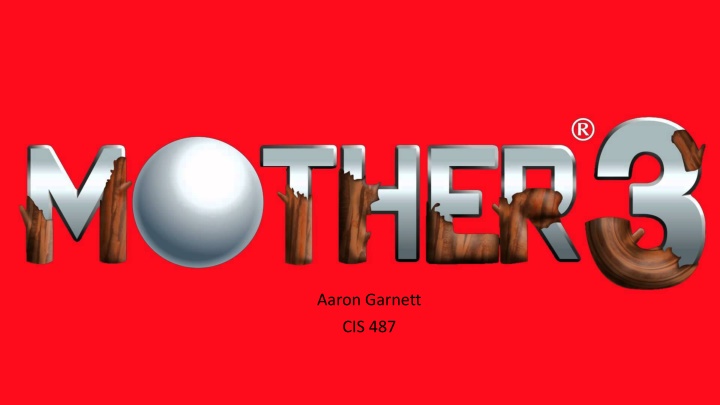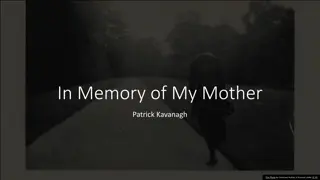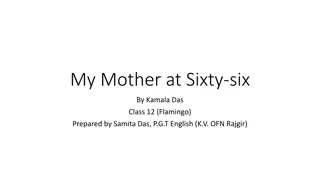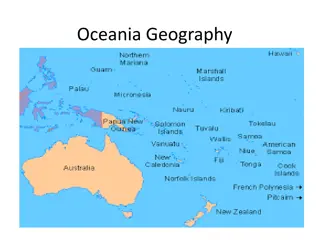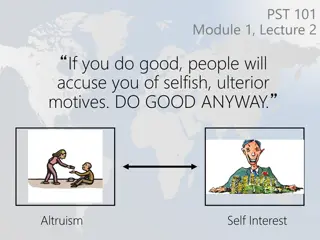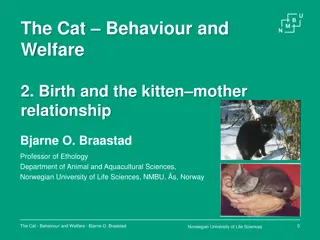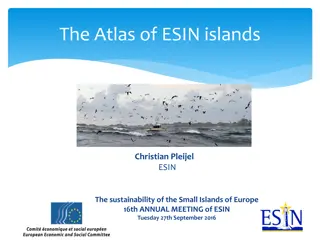Mother 3: A Role-Playing Adventure on the Nowhere Islands
Mother 3, developed by HAL Laboratories/Brownie Brown, follows the story of Lucas and his allies as they fight against the oppressive Pigmask Army on the mysterious Nowhere Islands. The game features a unique battle system with rolling health mechanics and rhythmic combat elements. Players explore the fictional world, engage in strategic battles, level up characters, and unravel the gripping narrative of resistance and friendship.
Download Presentation

Please find below an Image/Link to download the presentation.
The content on the website is provided AS IS for your information and personal use only. It may not be sold, licensed, or shared on other websites without obtaining consent from the author.If you encounter any issues during the download, it is possible that the publisher has removed the file from their server.
You are allowed to download the files provided on this website for personal or commercial use, subject to the condition that they are used lawfully. All files are the property of their respective owners.
The content on the website is provided AS IS for your information and personal use only. It may not be sold, licensed, or shared on other websites without obtaining consent from the author.
E N D
Presentation Transcript
Aaron Garnett CIS 487
Overview Mother 3 Developed by HAL Laboratories / Brownie Brown Published for the release on the Game Boy Advance Released on April 20, 2006 in Japan Japan only; fan translated on October 10, 2008 Price: $24.99 (Reproduction) Genre: Role-playing game 256 Mb Cartridge
Requirements/Installation Emulation Console Requirements: Game Boy Advance Emulator Mother 3 ROM file Minimum: Pentium 500Mhz/DirectX 7 Optimal: Pentium III 856Mhz/DirectX 7 Installation: Open emulator; file/open choose Mother 3 ROM file. Requirements: Game Boy Advance Installation: Insert cart into open slot on system.
Setting/Story Mother 3 is set in the Nowhere Islands. Chaos ensues after an invasion by the Pigmask Army, named after the uniforms, which resemble pigs. They slowly construct a police state, while experimenting on the land's flora and fauna, and introducing new technology and infrastructure to the islands. The various chapters record the life of a boy named Lucas and his family and friends, banding together to rid the Nowhere Islands of the Pigmask Army.
Gameplay The player controls up to four playable characters exploring the fictional world of the Nowhere Islands. Moving in the from a top-down perspective. While navigating the overworld, the player may converse with non-player characters, obtain items, or encounter enemies. When the player comes into contact with an enemy in the overworld, the game transitions to a battle screen. Battles are viewed from a first-person perspective. The player can assign each character in their party to perform an action, such as attacking an enemy or using items to restore HP or PP. Some characters can utilize psychic-based abilities referred to as PSI, which includes stronger attacks and healing abilities, and require PP to execute. combat uses a "rolling health" system: when one of the player's characters is injured, its HP will gradually "roll" down, similar to an odometer. When one of the player's characters directly attacks an enemy with a weapon, they can repeatedly attack the enemy by pressing the button in time with the beat of the background music, with each enemy possessing a musical theme with different rhythms. Using this system, the player can attack the enemy up to sixteen times in a row.
Scoring Winning battles against enemies awards experience points to the party, which is required for leveling up. Leveling up a character permanently enhances its individual attributes such as maximum hit points (HP), power points (PP), offense, and defense. Currency is introduced in the later half of the game as Dragon Points (DP), earned by winning battles and used to purchase items. The player loses a battle if all characters become unconscious; the player will then be given the option to continue play from the nearest save point, but with half the DP on their person.
Sound & Music Music by Shogo Sakai Main Theme of the game entitled Love Theme Pigmask Army is a common reoccurring theme. Multiple music for different encounters with enemies. Each musical theme has a rhythm beat. Each character has different sound effect for when they attack an enemy. Many music pieces are references to real music.
This is a deep game. The story is lament told in such a way that is meant to invoke different emotions on the player. Story contains many thought provoking themes such as: feudalism versus technocracy, darwinistic natural selection, nature versus technology, and individualism and conformity among many others. Has a cinematic approach. Very expressive sprites Many memorable cut scenes Interesting set pieces Still contains that quirky, humorous tone that its predecessors had. Gameplay is simple to the point that anyone can play without much trouble.
Weaker Elements? Has very archaic inventory system in which each character has a limited inventory that only they can use, every takes up a space (no staking of same items), and even equipment for your characters will take up inventory space. Item usage isn t always demanding so inventory can especially fill up quickly. Slightly mitigated by a never scarce depository system. Gameplay is nothing innovative or complex; rhythm mechanic is merely a gimmick that isn t really necessary to use even if useful. It can be fun, but nothing special
Compared to its Predecessor Due to its cinematic approach the game may be less accessible than Earthbound (Mother 2); in Mother 3 your in it from beginning to end while earthbound can be play on and off. Mother 3 however has more appeal to the general audience the Earthbound. Improvements Better Inventory System Other quality of life improvements in presentation. More innovating gameplay.
Summary The game engaging because of its story and its characters, and while many gameplay elements can still be fun the game more about the experience rather the gameplay. May be better of emulating, but physical purchase is still recommended. If there was an answer to whether or not video games are art, it would be this game.
Audience The game is niche definitely, but can be appealing to anyone really. It has no official ESRB rating. Its mature themes are well suited for teens to adults.
